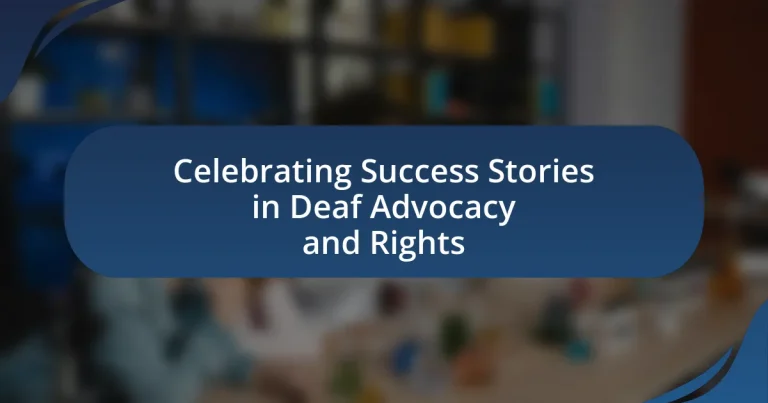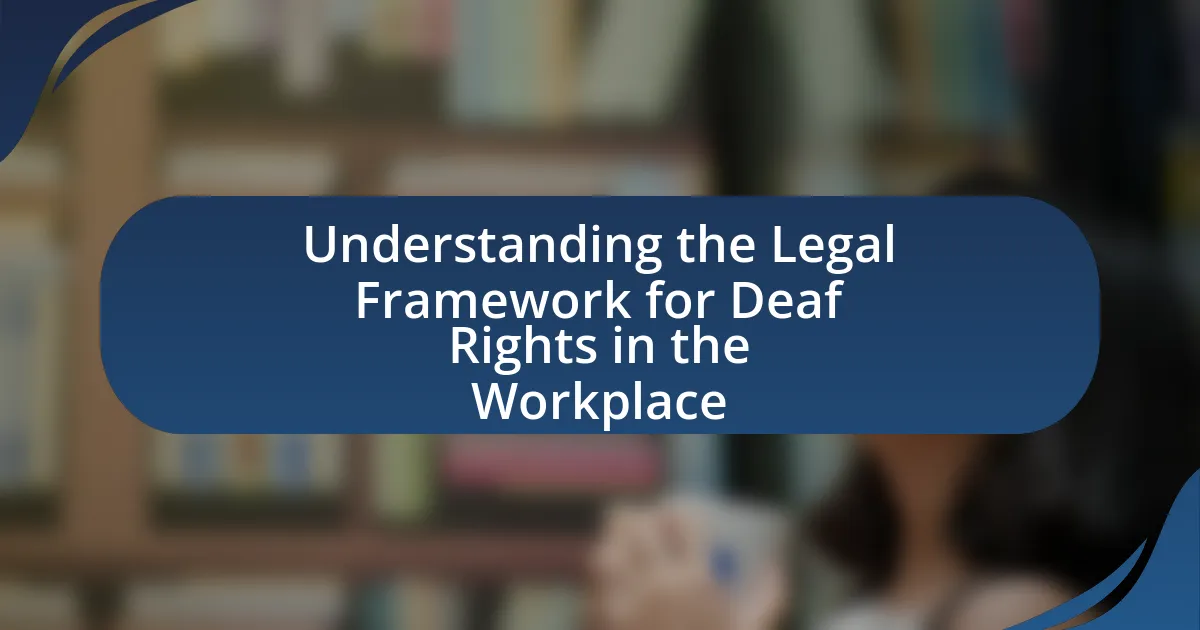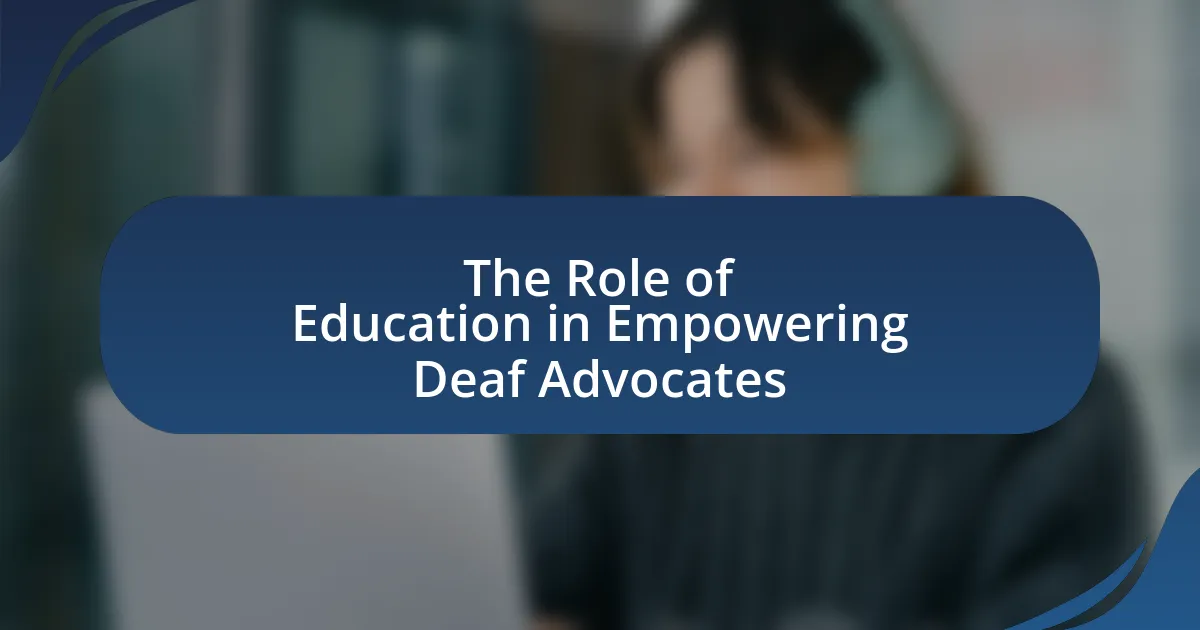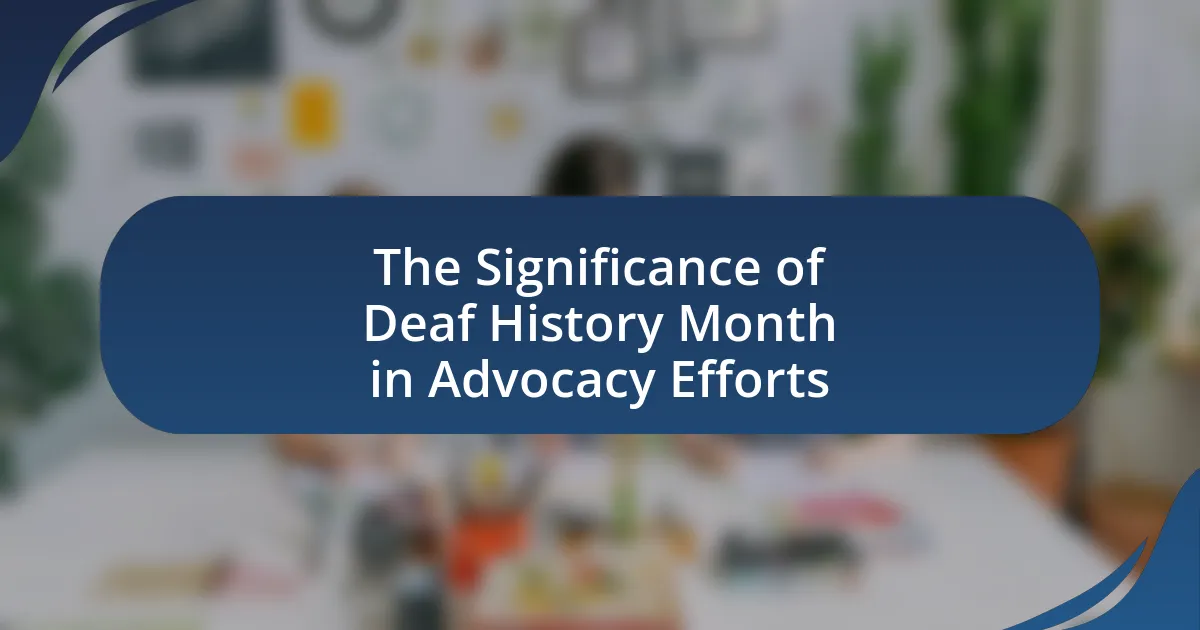Success stories in deaf advocacy and rights highlight significant achievements that have improved the lives of deaf individuals, including the establishment of legal protections like the Americans with Disabilities Act (ADA) and the recognition of American Sign Language (ASL). These successes have empowered the Deaf community by enhancing visibility, promoting acceptance, and inspiring future advocacy efforts. Key areas of focus include access to education, employment opportunities, healthcare services, and legal rights, all of which contribute to the overall success of Deaf rights. Celebrating these achievements fosters community solidarity and encourages ongoing engagement in advocacy initiatives, while lessons learned from past successes inform future strategies for promoting equality and accessibility for the Deaf community.
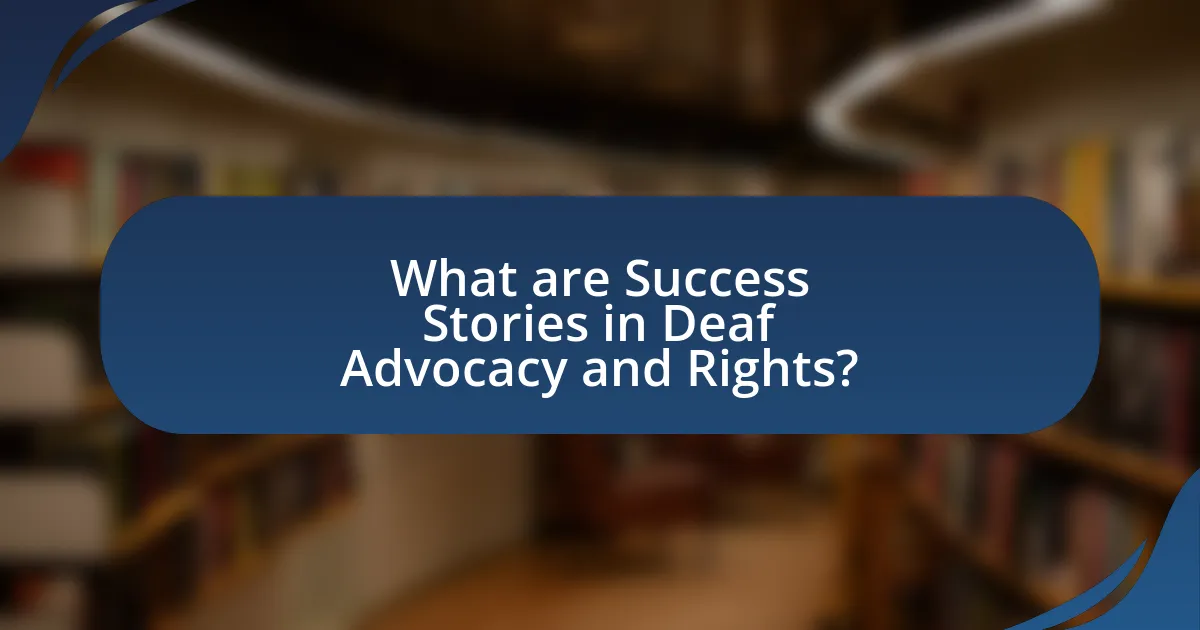
What are Success Stories in Deaf Advocacy and Rights?
Success stories in deaf advocacy and rights refer to significant achievements that have improved the lives and rights of deaf individuals. These successes include the establishment of legal protections, such as the Americans with Disabilities Act (ADA) in 1990, which prohibits discrimination against individuals with disabilities, including those who are deaf. Additionally, the recognition of American Sign Language (ASL) as a legitimate language has led to increased access to education and services for deaf individuals. Advocacy efforts have resulted in improved access to interpreters in public services, enhancing communication and inclusion. These milestones demonstrate the effectiveness of advocacy in promoting equality and accessibility for the deaf community.
How have these success stories impacted the Deaf community?
Success stories in Deaf advocacy and rights have significantly empowered the Deaf community by enhancing visibility and promoting acceptance. These narratives showcase the achievements of Deaf individuals, illustrating their capabilities and contributions, which helps to challenge stereotypes and misconceptions about Deafness. For instance, the success of Deaf artists and professionals in various fields has led to increased representation in media and culture, fostering a more inclusive society. Additionally, these stories often inspire younger Deaf individuals, providing role models and encouraging them to pursue their aspirations. Research indicates that representation in media can positively influence self-esteem and identity among marginalized groups, further validating the impact of these success stories on the Deaf community.
What specific achievements are highlighted in these success stories?
The specific achievements highlighted in these success stories include the successful implementation of inclusive education programs, increased accessibility to public services, and the establishment of legal protections for deaf individuals. These achievements demonstrate significant progress in advocating for the rights of the deaf community, as evidenced by statistics showing a rise in enrollment rates in schools for deaf students and the passage of legislation that mandates accommodations in workplaces and public spaces.
How do these achievements inspire future advocacy efforts?
Achievements in deaf advocacy inspire future efforts by demonstrating the effectiveness of organized action and community engagement. For instance, the successful implementation of policies that promote accessibility in education and employment showcases how collective advocacy can lead to tangible changes. These successes serve as models for future campaigns, encouraging advocates to adopt similar strategies and collaborate with stakeholders. Furthermore, the visibility gained from these achievements raises awareness about deaf rights, motivating new advocates to join the movement and build upon established successes.
Why is it important to celebrate these success stories?
Celebrating success stories in deaf advocacy and rights is important because it highlights achievements that inspire and motivate the community. These stories serve as tangible evidence of progress, demonstrating that advocacy efforts can lead to meaningful change, such as improved access to education and employment opportunities for deaf individuals. For instance, the passage of the Americans with Disabilities Act in 1990 marked a significant milestone in civil rights for people with disabilities, including the deaf community, showcasing the impact of advocacy. By recognizing these successes, the community can foster a sense of pride and solidarity, encouraging further engagement and activism.
What role does recognition play in advancing Deaf rights?
Recognition plays a crucial role in advancing Deaf rights by validating the cultural and linguistic identity of Deaf individuals. This acknowledgment fosters greater awareness and understanding of Deaf issues, leading to increased advocacy for equal rights and access to services. For instance, the recognition of sign language as an official language in various countries has resulted in improved educational opportunities and legal protections for Deaf communities, as seen in nations like New Zealand and South Africa. Such legal frameworks empower Deaf individuals, ensuring their rights are respected and upheld in society.
How can celebrating success stories foster community solidarity?
Celebrating success stories fosters community solidarity by creating shared experiences and reinforcing collective identity among members. When individuals within a community recognize and celebrate achievements, it cultivates a sense of belonging and mutual support. For instance, in the context of Deaf advocacy, highlighting successful initiatives or individuals can inspire others, demonstrating that collective efforts lead to tangible outcomes. Research indicates that communities that celebrate their members’ successes experience increased engagement and collaboration, as seen in studies by the National Institute for Deafness and Other Communication Disorders, which show that shared narratives enhance social cohesion and motivate further participation in advocacy efforts.
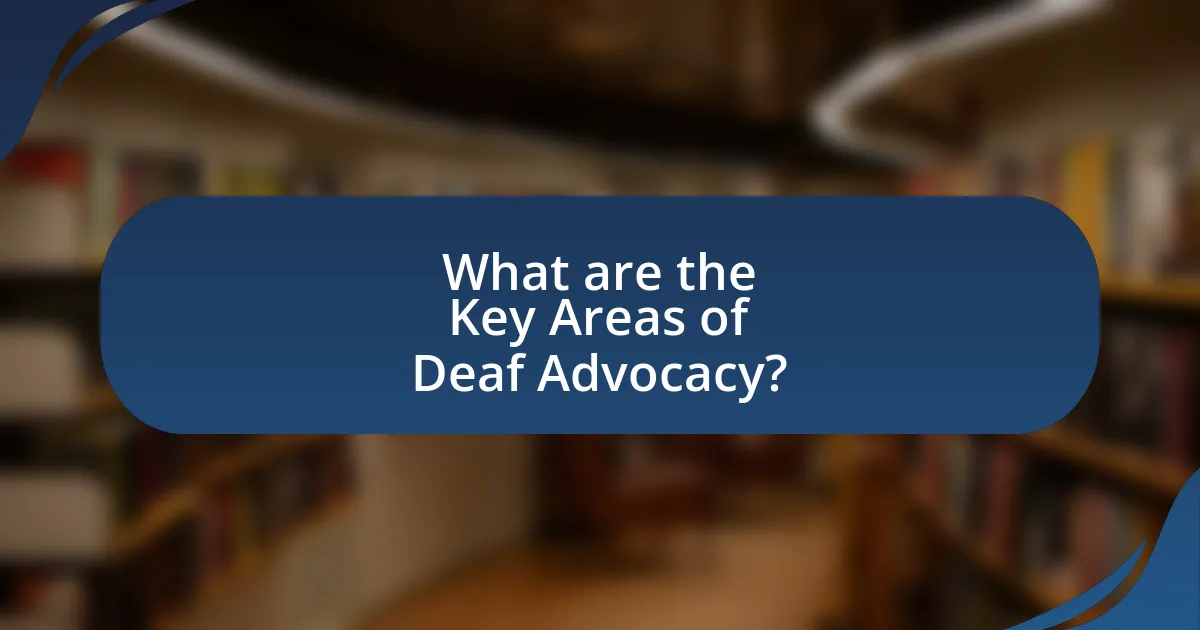
What are the Key Areas of Deaf Advocacy?
The key areas of deaf advocacy include access to education, employment opportunities, healthcare services, and legal rights. Access to education ensures that deaf individuals receive appropriate resources and support, such as sign language interpreters and specialized teaching methods, which are essential for effective learning. Employment opportunities focus on promoting workplace inclusivity and combating discrimination, as studies show that deaf individuals often face significant barriers in the job market. Healthcare services advocacy emphasizes the need for accessible communication in medical settings, ensuring that deaf patients can fully understand their health conditions and treatment options. Lastly, legal rights advocacy aims to protect and promote the rights of deaf individuals under laws such as the Americans with Disabilities Act, which mandates equal access and prohibits discrimination. These areas collectively contribute to improving the quality of life for deaf individuals and fostering a more inclusive society.
How do these areas contribute to the overall success of Deaf rights?
The areas of education, legislation, and community engagement significantly contribute to the overall success of Deaf rights. Education empowers Deaf individuals by providing access to resources and knowledge, which fosters independence and advocacy skills. Legislation, such as the Americans with Disabilities Act, establishes legal protections and ensures equal opportunities, thereby reinforcing the rights of Deaf individuals. Community engagement promotes awareness and solidarity, creating a supportive environment that amplifies Deaf voices and encourages collective action. These elements work synergistically to enhance visibility, promote inclusivity, and drive systemic change, ultimately leading to greater recognition and respect for Deaf rights.
What are the major milestones in education advocacy for the Deaf?
Major milestones in education advocacy for the Deaf include the establishment of the American School for the Deaf in 1817, which was the first permanent school for Deaf students in the United States. This was followed by the passage of the Individuals with Disabilities Education Act (IDEA) in 1975, ensuring that Deaf students have the right to a free and appropriate public education. Another significant milestone was the recognition of American Sign Language (ASL) as a legitimate language in the 1960s, which helped promote its use in educational settings. Additionally, the 1990 Americans with Disabilities Act (ADA) further solidified the rights of Deaf individuals, including access to education. These milestones collectively advanced educational opportunities and rights for Deaf individuals, fostering greater inclusion and support within the educational system.
How has employment advocacy changed the landscape for Deaf individuals?
Employment advocacy has significantly improved job opportunities and workplace inclusivity for Deaf individuals. This shift has been driven by increased awareness of the rights of Deaf individuals, leading to the implementation of policies that promote equal employment opportunities. For instance, the Americans with Disabilities Act (ADA) mandates reasonable accommodations in the workplace, which has resulted in more Deaf individuals gaining access to jobs that were previously inaccessible. Additionally, organizations focused on Deaf advocacy have successfully lobbied for better training programs and resources that equip Deaf individuals with the skills needed to thrive in various industries. These efforts have contributed to a more equitable job market, where Deaf individuals can participate fully and contribute their unique perspectives.
What challenges have been overcome in these areas?
Significant challenges in deaf advocacy and rights have been overcome, including the fight for equal access to education, employment opportunities, and healthcare services. For instance, the implementation of the Individuals with Disabilities Education Act (IDEA) in the United States has ensured that deaf students receive appropriate educational resources and support, leading to improved academic outcomes. Additionally, the establishment of the Americans with Disabilities Act (ADA) has mandated accessibility in public spaces and workplaces, promoting inclusion and reducing discrimination against deaf individuals. These legislative advancements demonstrate a commitment to addressing historical inequities faced by the deaf community.
What strategies were effective in overcoming these challenges?
Effective strategies in overcoming challenges in deaf advocacy and rights include community engagement, legislative advocacy, and educational initiatives. Community engagement fosters solidarity and support among deaf individuals, enabling them to share experiences and resources. Legislative advocacy has led to significant policy changes, such as the Americans with Disabilities Act, which mandates accessibility and equal rights for individuals with disabilities. Educational initiatives, including awareness campaigns and training programs, have increased understanding and acceptance of deaf culture, thereby reducing stigma and discrimination. These strategies collectively empower the deaf community and promote their rights effectively.
How can these strategies be applied to future advocacy efforts?
Strategies from celebrating success stories in Deaf advocacy can be applied to future advocacy efforts by leveraging storytelling to highlight achievements and foster community engagement. By showcasing successful initiatives, advocates can inspire others, build momentum, and attract support from stakeholders. For instance, the National Association of the Deaf has effectively used success stories to raise awareness and influence policy changes, demonstrating that tangible examples can mobilize resources and encourage participation. This approach not only validates the efforts of the community but also serves as a blueprint for replicating successful strategies in new contexts.
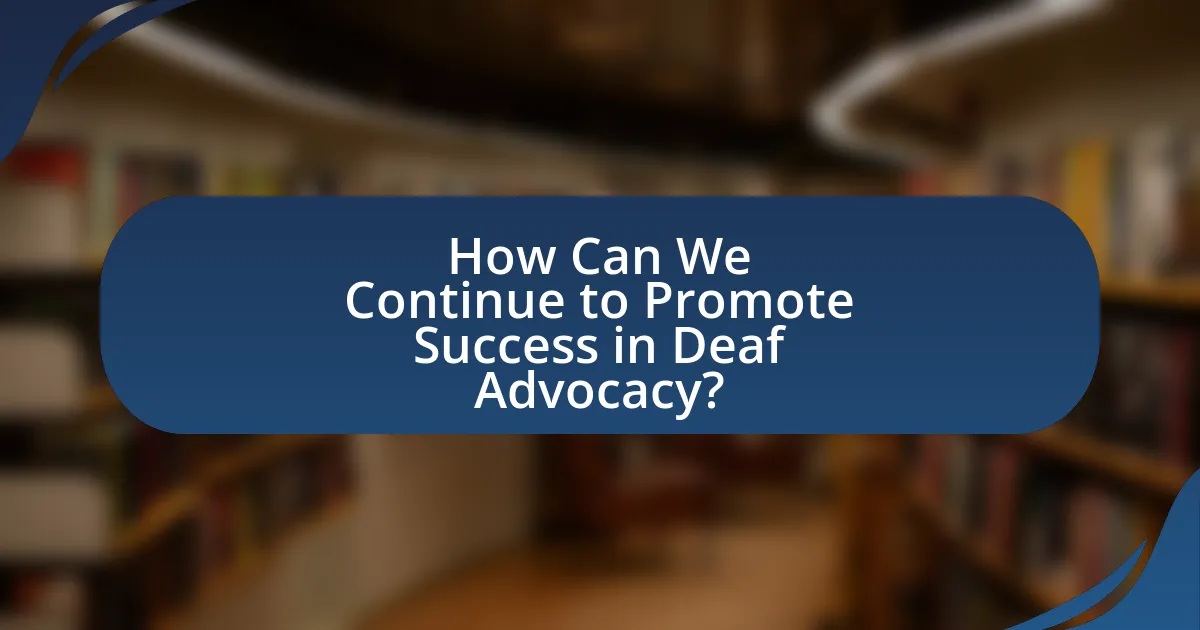
How Can We Continue to Promote Success in Deaf Advocacy?
To continue promoting success in deaf advocacy, it is essential to enhance awareness and education about deaf culture and rights. Increasing public understanding can lead to greater support for policies that benefit the deaf community. For instance, research from the National Association of the Deaf indicates that informed communities are more likely to advocate for inclusive practices and legislation, such as the Americans with Disabilities Act, which has significantly improved access for deaf individuals. Engaging in partnerships with organizations that focus on disability rights can also amplify advocacy efforts, ensuring that the voices of deaf individuals are heard and represented in broader discussions about accessibility and inclusion.
What are the best practices for advocating for Deaf rights today?
The best practices for advocating for Deaf rights today include promoting accessibility, fostering community engagement, and supporting policy changes. Advocates should ensure that public spaces, educational institutions, and workplaces are equipped with necessary accommodations such as sign language interpreters and captioning services. Engaging the Deaf community in advocacy efforts is crucial, as it empowers individuals to share their experiences and needs, leading to more effective advocacy. Additionally, supporting legislative initiatives that protect and enhance Deaf rights, such as the Americans with Disabilities Act, is essential for creating systemic change. These practices are validated by successful advocacy campaigns that have led to increased awareness and improved rights for Deaf individuals in various sectors.
How can individuals contribute to ongoing advocacy efforts?
Individuals can contribute to ongoing advocacy efforts by actively participating in community initiatives, raising awareness, and supporting organizations focused on deaf advocacy and rights. Engaging in local events, volunteering time, and donating resources to organizations like the National Association of the Deaf can amplify the impact of advocacy efforts. Research shows that grassroots movements, where individuals mobilize to support a cause, can lead to significant policy changes and increased visibility for issues affecting the deaf community. For instance, the 2019 Deaf Rights Movement in the United States saw increased legislative support due to widespread community involvement and advocacy campaigns.
What resources are available for those looking to support Deaf advocacy?
Organizations such as the National Association of the Deaf (NAD) and the Deaf Advocacy Network provide essential resources for individuals looking to support Deaf advocacy. The NAD offers advocacy training, legal resources, and information on policy issues affecting the Deaf community, while the Deaf Advocacy Network focuses on grassroots efforts and community engagement. Additionally, online platforms like the Deaf Community Facebook groups and websites such as Deafhood Foundation provide forums for discussion, sharing success stories, and mobilizing support for Deaf rights initiatives. These resources collectively empower advocates to effectively contribute to the advancement of Deaf rights and awareness.
What lessons can be learned from past success stories?
Lessons learned from past success stories in deaf advocacy and rights include the importance of community engagement, effective communication strategies, and the need for policy change. Community engagement fosters a sense of belonging and empowerment, as seen in the success of organizations like the National Association of the Deaf, which mobilized grassroots support to influence legislation. Effective communication strategies, such as the use of sign language interpreters and accessible materials, have proven essential in ensuring that deaf individuals can participate fully in advocacy efforts. Additionally, successful advocacy often leads to significant policy changes, such as the Americans with Disabilities Act of 1990, which has greatly improved accessibility and rights for deaf individuals. These elements highlight the critical factors that contribute to successful advocacy outcomes.
How can these lessons inform future advocacy strategies?
Lessons from successful deaf advocacy can inform future strategies by highlighting effective communication methods and community engagement practices. For instance, the use of storytelling in advocacy campaigns has proven to resonate deeply with both policymakers and the public, as seen in campaigns that successfully raised awareness about deaf rights. Additionally, collaboration with deaf individuals and organizations ensures that advocacy efforts are authentic and address the actual needs of the community, as demonstrated by initiatives that have led to improved access to education and employment for deaf individuals. These strategies, grounded in real-world successes, provide a roadmap for future advocacy efforts to be more impactful and inclusive.
What common themes emerge from successful Deaf advocacy initiatives?
Successful Deaf advocacy initiatives commonly emphasize themes of accessibility, community empowerment, and cultural recognition. Accessibility is crucial, as initiatives often focus on ensuring that Deaf individuals have equal access to education, employment, and public services, which is supported by the Americans with Disabilities Act (ADA) mandating such provisions. Community empowerment is another key theme, where advocacy efforts encourage Deaf individuals to take leadership roles and actively participate in decision-making processes, fostering a sense of ownership and agency. Cultural recognition highlights the importance of valuing Deaf culture and American Sign Language (ASL), which is essential for promoting identity and pride within the Deaf community. These themes collectively contribute to the effectiveness of advocacy initiatives, as evidenced by successful campaigns that have led to policy changes and increased awareness of Deaf rights.
What practical steps can individuals take to celebrate and support Deaf advocacy?
Individuals can celebrate and support Deaf advocacy by actively participating in Deaf community events, such as Deaf Awareness Month activities, which promote understanding and appreciation of Deaf culture. Engaging with local Deaf organizations through volunteering or donations helps to strengthen advocacy efforts and provide resources for the community. Additionally, learning sign language enhances communication and fosters inclusivity, demonstrating respect for Deaf individuals. Supporting Deaf-owned businesses and artists also contributes to economic empowerment within the community. Research indicates that increased visibility and support for Deaf advocacy initiatives lead to greater societal acceptance and policy changes that benefit Deaf individuals.
